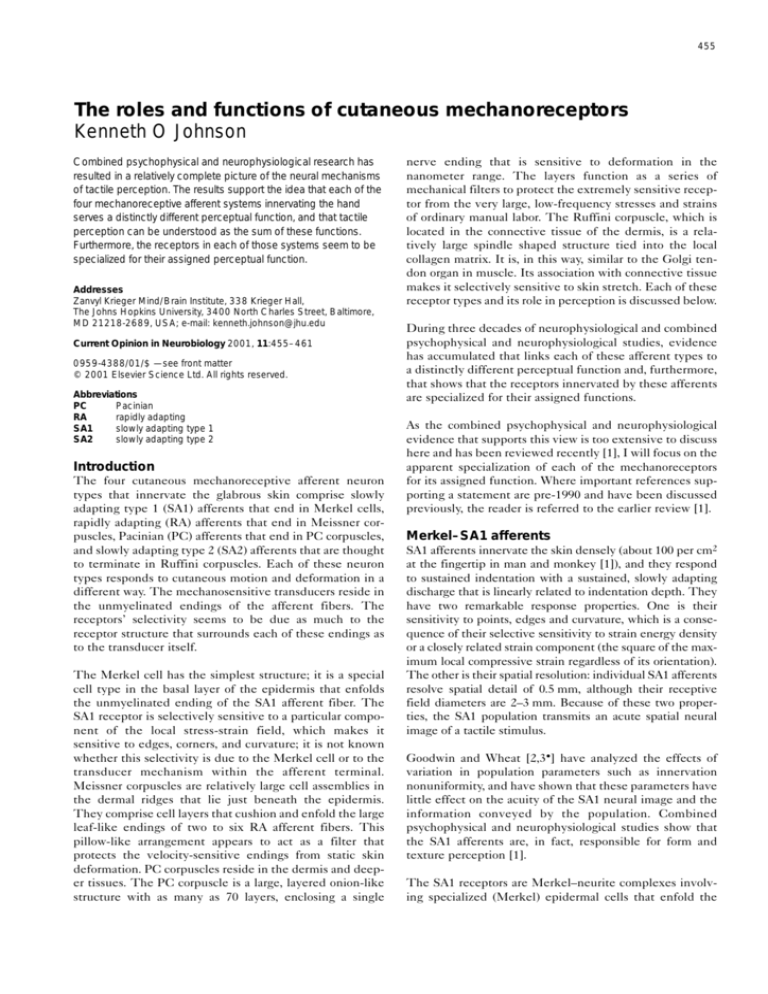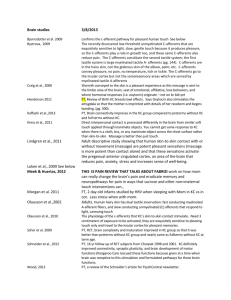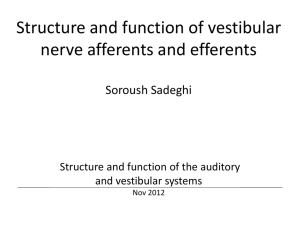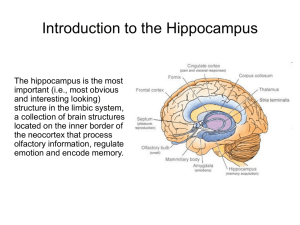
455
The roles and functions of cutaneous mechanoreceptors
Kenneth O Johnson
Combined psychophysical and neurophysiological research has
resulted in a relatively complete picture of the neural mechanisms
of tactile perception. The results support the idea that each of the
four mechanoreceptive afferent systems innervating the hand
serves a distinctly different perceptual function, and that tactile
perception can be understood as the sum of these functions.
Furthermore, the receptors in each of those systems seem to be
specialized for their assigned perceptual function.
Addresses
Zanvyl Krieger Mind/Brain Institute, 338 Krieger Hall,
The Johns Hopkins University, 3400 North Charles Street, Baltimore,
MD 21218-2689, USA; e-mail: kenneth.johnson@jhu.edu
Current Opinion in Neurobiology 2001, 11:455–461
0959-4388/01/$ — see front matter
© 2001 Elsevier Science Ltd. All rights reserved.
Abbreviations
PC
Pacinian
RA
rapidly adapting
SA1
slowly adapting type 1
SA2
slowly adapting type 2
Introduction
The four cutaneous mechanoreceptive afferent neuron
types that innervate the glabrous skin comprise slowly
adapting type 1 (SA1) afferents that end in Merkel cells,
rapidly adapting (RA) afferents that end in Meissner corpuscles, Pacinian (PC) afferents that end in PC corpuscles,
and slowly adapting type 2 (SA2) afferents that are thought
to terminate in Ruffini corpuscles. Each of these neuron
types responds to cutaneous motion and deformation in a
different way. The mechanosensitive transducers reside in
the unmyelinated endings of the afferent fibers. The
receptors’ selectivity seems to be due as much to the
receptor structure that surrounds each of these endings as
to the transducer itself.
The Merkel cell has the simplest structure; it is a special
cell type in the basal layer of the epidermis that enfolds
the unmyelinated ending of the SA1 afferent fiber. The
SA1 receptor is selectively sensitive to a particular component of the local stress-strain field, which makes it
sensitive to edges, corners, and curvature; it is not known
whether this selectivity is due to the Merkel cell or to the
transducer mechanism within the afferent terminal.
Meissner corpuscles are relatively large cell assemblies in
the dermal ridges that lie just beneath the epidermis.
They comprise cell layers that cushion and enfold the large
leaf-like endings of two to six RA afferent fibers. This
pillow-like arrangement appears to act as a filter that
protects the velocity-sensitive endings from static skin
deformation. PC corpuscles reside in the dermis and deeper tissues. The PC corpuscle is a large, layered onion-like
structure with as many as 70 layers, enclosing a single
nerve ending that is sensitive to deformation in the
nanometer range. The layers function as a series of
mechanical filters to protect the extremely sensitive receptor from the very large, low-frequency stresses and strains
of ordinary manual labor. The Ruffini corpuscle, which is
located in the connective tissue of the dermis, is a relatively large spindle shaped structure tied into the local
collagen matrix. It is, in this way, similar to the Golgi tendon organ in muscle. Its association with connective tissue
makes it selectively sensitive to skin stretch. Each of these
receptor types and its role in perception is discussed below.
During three decades of neurophysiological and combined
psychophysical and neurophysiological studies, evidence
has accumulated that links each of these afferent types to
a distinctly different perceptual function and, furthermore,
that shows that the receptors innervated by these afferents
are specialized for their assigned functions.
As the combined psychophysical and neurophysiological
evidence that supports this view is too extensive to discuss
here and has been reviewed recently [1], I will focus on the
apparent specialization of each of the mechanoreceptors
for its assigned function. Where important references supporting a statement are pre-1990 and have been discussed
previously, the reader is referred to the earlier review [1].
Merkel–SA1 afferents
SA1 afferents innervate the skin densely (about 100 per cm2
at the fingertip in man and monkey [1]), and they respond
to sustained indentation with a sustained, slowly adapting
discharge that is linearly related to indentation depth. They
have two remarkable response properties. One is their
sensitivity to points, edges and curvature, which is a consequence of their selective sensitivity to strain energy density
or a closely related strain component (the square of the maximum local compressive strain regardless of its orientation).
The other is their spatial resolution: individual SA1 afferents
resolve spatial detail of 0.5 mm, although their receptive
field diameters are 2–3 mm. Because of these two properties, the SA1 population transmits an acute spatial neural
image of a tactile stimulus.
Goodwin and Wheat [2,3•] have analyzed the effects of
variation in population parameters such as innervation
nonuniformity, and have shown that these parameters have
little effect on the acuity of the SA1 neural image and the
information conveyed by the population. Combined
psychophysical and neurophysiological studies show that
the SA1 afferents are, in fact, responsible for form and
texture perception [1].
The SA1 receptors are Merkel–neurite complexes involving specialized (Merkel) epidermal cells that enfold the
456
Sensory systems
Figure 1
100
The receptive field of an SA1 afferent has hot spots that
undoubtedly correspond to individual branches of the
afferent axon [7,8]. When the spatial detail becomes finer
than the receptive field diameter, a single skin spot (i.e., a
single terminal branch) becomes dominant, which
accounts for the fact that SA1 afferents resolve spatial
detail smaller than their receptive field diameters [7].
SA1
50
Figure 1 illustrates the SA1 afferent’s two principal
response properties: high spatial resolution, and responsiveness to stimulus features such as edges and bars rather
than to indentation per se. The modulation of SA1 firing
rates beginning at 0.5 mm wide gaps parallels closely the
human psychometric function for discriminating grating
orientation. Human discrimination begins to rise above
chance behavior when gaps and bars are 0.5 mm wide and
reaches threshold when they are about 1.0 mm wide [9,10].
The selective sensitivity for edges and bars illustrated
in Figure 1 arises from the Merkel receptor’s selective
sensitivity to strain energy density or a closely related component of tissue strain [11–13].
Impulses per trial (duration 1.0 s)
0
RA
10
0
20
PC
SA1, RA and PC responses to an aperiodic grating pressed into the
skin. The grating is shown in cross-section beneath each response
profile. The end bars are 3.0 mm wide; the internal bars are 0.5 mm
wide. The grooves are deeper than illustrated (2.0 mm deep) and are
0.5, 0.5, 0.75, 1.0, 1.5, 2.0, 3.0 and 5.0 mm wide. The grating
indented the skin by 1 mm for 1 s, was raised and moved laterally
0.2 mm for the next indentation. The ordinate represents the number of
action potentials evoked during each 1-s period. RA and PC afferents
responded during the indentation phase only, which accounts for their
smaller impulse counts. The abscissa for each plot represents the
position of the receptive field center relative to the grating; for example,
the left peak in the SA1 response profile (95 impulses per s) occurred
when the center of the SA1 RF was directly beneath the left edge of
the grating. The RA illustrated here was the most sensitive to spatial
detail out of all RAs studied. Most RA responses dipped only during
the 5 mm gap and some barely registered the presence of the 5 mm
gap even though they responded vigorously at all grating positions.
Testing progressed from right to left. The progressive decline in PC
responses results from adaptation to the repeated indentations.
Adapted with permission from [7].
An additional quality that makes SA1 afferents particularly
suited to the representation of surface or object form is its
linear response to skin deformation over a very wide range
of deformations. SA1 afferents respond to skin indentation
to depths of at least 1500 µm with a linear discharge rate
[1,6,14]; in contrast, the RA afferent response begins to saturate at about 100 µm [6] and is insensitive to the height of
surface features above 300–400 µm [14,15]. Because of the
linearity and the SA1 responsiveness to strain energy density, the SA1 afferents represent object curvature very
accurately as shown by a number of studies [2,16–19,20•].
For example, Goodwin et al. [16] showed that only SA1
afferents provide the brain with a veridical neural image of
a curved surface — an image that could be used for the
perception of curvature. LaMotte and Srinivasan [17]
scanned a series of cylindrical waves with varying curvature across the receptive fields of SA1 and RA afferents.
They found that the discharge rates of both afferent types
were related to surface curvature, but SA1 firing rates represented the shapes of the cylindrical wave more
effectively than did the RA firing rates [17]. Finally,
Dodson et al. [19] showed that the human threshold for
object orientation is 4 to 5 degrees at the fingertip. Only
the SA1 population provides a neural image of the
stimulus and its orientation that can account for the
psychophysical behavior.
unmyelinated ends of SA1 axons [1]. Although there are
synapse-like junctions between the Merkel cells and the
axon terminals, action potentials appear to arise as the
result of mechanosensitive ion channels in the bare nerve
endings [4,5]. As individual SA1 afferent axons approach
the epidermis, they branch over an area of about 5 mm2 [6]
and innervate a large but unknown number of Merkel
receptors (100 is an estimate of the order of magnitude).
Goodwin and colleagues have shown also that humans can
discriminate curvature independent of contact force [21]
and contact area [22], which implies that subjects rely on
the spatial profile of the neural activity evoked by a curved
surface rather than some intensive cue like total impulse
rate. Figure 2 illustrates the SA1 neural activity evoked by
a series of curved surfaces. No other afferent type provides
a representation on which curvature discrimination might
be based [16,23,24].
10
0
0.5 mm bar width
5.0 mm
Current Opinion in Neurobiology
The roles and functions of cutaneous mechanoreceptors Johnson
457
Figure 2
694m-1
x=0
Normalized response
1.5
1.0
0.5
0
x=0.0
x=0.5
x=1.0
x=1.5
x=2.0
x=2.5
1.5
Normalized response
694 m-1
521 m-1
340 m-1
256 m-1
172 m-1
80.6 m-1
0 m-1
1.0
0.5
0
-4
-2
0
2
y distance (mm)
4
-4
-2
0
2
y distance (mm)
4
Current Opinion in Neurobiology
Population response of peripheral SA1 afferents to indentation with
spheres of varying curvature. The left plot shows the mean responses
of SA1 afferents as a function of proximal–distal distance from the
center of indentation. Data are shown for seven curved surfaces with
radii ranging from 1.4 mm (curvature = 694 m–1) to a flat surface
(curvature = 0 m—1). The right plot shows population response profiles
in proximal–distal slices at varying distances from the center of
indentation. Adapted with permission from [16].
There is other evidence of SA1 specialization for the
representation of spatial information:
[1,7,21,22]. The psychophysical correlate of point 4 is tactile
spatial pattern recognition at scanning velocity up to at least
80 mm s–1 [28]. The psychophysical correlate of point 5 is
much greater sensitivity to form and texture when fingers scan
a surface than when they are stationary. David Katz [29] has
said that “movement [is] as indispensable for touch as light is
for color sensations”. The SA1 sensitivity to motion is the basis
of this observation. The psychophysical correlate of point 6 is
the human ability to discriminate surface form. For example,
humans can reliably discriminate surfaces with dots or ridges,
even when their spacings differ by as little as 2% [30,31].
1. SA1 responses to stimulus elements on a surface are
independent of the force of application [25].
2. SA1-receptive fields grow minimally (relative to RA
receptive fields) with increasing indentation depth [6].
3. SA1 afferents possess a response property, surround suppression, which confers response properties similar to
those produced by surround inhibition in the central
nervous system [25]. This response property is a consequence of sensitivity to strain energy density, not a
synaptic mechanism.
4. SA1 spatial resolution is affected minimally by changes
in scanning velocity at velocities up to at least 80 mm s–1
[26,27].
5. SA1 afferents are at least ten times more sensitive to
dynamic than to static stimuli [1].
6. SA1 responses to repeated skin indentation are practically invariant: the variability is about one impulse per trial
regardless of the number of action potentials evoked [6].
The psychophysical correlate of points 1 and 2 is that tactile
pattern recognition is independent of contact force [1]. The
psychophysical correlate of point 3 is much greater sensitivity
to curvature and surface features than to indentation per se
Meissner–RA afferents
Meissner afferents innervate the skin even more densely
(about 150 per cm2 at the fingertip in man and monkey [1])
than do the SA1 afferents, they are insensitive to static skin
deformation, and they are four time more sensitive to
dynamic skin deformation than are SA1 afferents. Unlike
SA1 afferents, they respond to stimuli over their entire
receptive fields (3–5 mm in diameter) with relative
uniformity and therefore resolve spatial detail poorly. A
mechanistic interpretation is that, unlike the SA1 afferents, all the terminal branches of an RA afferent contribute
equally when multiple endings are stimulated simultaneously by dense spatial detail.
Because of this wide, uniform sensitivity, RA afferents
transmit a robust neural image of skin motion. For many
years, they have been known to be responsible for the
detection and discrimination of low frequency vibration [1].
A more recent observation is that they are responsible for
458
Sensory systems
detecting slip between the skin and an object held in the
hand [1,32] and that, of the four afferent types, they are the
most effective at signaling sudden forces that act on objects
held in the hand [33]. Considering the importance of prehension, the RA’s most important function would seem to
be the provision of feedback signals for grip control [33,34].
Individual RA afferent nerve fibers end as unmyelinated,
disk-like endings within Meissner’s corpuscles, which occur in
dermal pockets between the sweat ducts and adhesive ridges
[1,35]. This position places the RA afferents as close to the
surface of the epidermis as is possible within the dermis. This
may account, in part, for the greater sensitivity of RA afferents
to minute skin deformation relative to SA1 afferents, whose
receptors are on the tips of the deepest epidermal ridges.
It is difficult to think of a more important role for the RA
afferents than as the essential feedback sensors for grip
control. Johansson and colleagues [1,33,34] have shown
that as we lift and manipulate an object there are frequent
microscopic slips between the object and the skin, and that
the skin motion associated with these slips evokes reflexive increases in grip force.
This constant adjustment allows us to manipulate objects
with delicacy — with grip forces not far above the forces
that result in overt slip. A complication is that the required
grip forces depend on factors like surface coefficient of
friction as well as the object’s weight. The evidence from
microneurographic recordings in humans as they lift and
manipulate objects and in controlled psychophysical and
neurophysiological experiments is that RA afferents provide the signals that are critical for grip control [1,32–34].
The RA afferent responses possess several qualities that
appear to be specialized for this function. First, studies
using indentation, vibration and scanned raised elements
have shown that RA afferents are four times more sensitive
to skin motion than SA1 afferents [1]. Second, as illustrated in Figure 1, they are more uniformly sensitive to stimuli
within their receptive fields than are SA1 afferents
[6,7,36,37]. RAs fail to represent the gaps in a grating until
they are 3–5 mm wide because of their uniform responsiveness over receptive fields that are 3–5 mm wide. The
result is poor spatial acuity but a robust response to local
events such as slip. On the basis of their innervation density at the fingertip (150 per cm2) and their receptive field
sizes (10–30 mm2) it can be estimated that 15–50 RA afferents signal transient local skin motion. Third, they are
insensitive to static force and very low-frequency vibration. If they were not, the response to forces required to
grip an object would mask the small signals produced by
local microslip. The basis of this insensitivity is probably
the fluid-filled corpuscle within which the very sensitive
receptors reside (see section on PC corpuscles below).
The RA and SA1 systems are, in some ways like the scotopic and photopic systems in vision. The RA system, like
the scotopic system, has greater sensitivity but poorer spatial resolution and limited dynamic range. The SA1 system,
like the photopic system, is less sensitive but has higher
spatial resolution and operates over a wider dynamic range.
Pacinian afferents
PC afferents terminate in single corpuscles [38] that are
distributed throughout the palm and fingers (about 350 per
finger and 800 in the palm) [1]. These afferents have three
remarkable response properties.
The first is their extreme sensitivity: the most sensitive PC
afferents respond to 10 nm of skin motion or less at 200 Hz
[39]. Because of their extreme sensitivity and the deep
locations of PC receptors, PC afferents have almost no spatial resolution, as can be seen in Figure 1. The receptive
field of a PC receptor may include an entire hand. The second is their intense filtering (at nearly 60 dB per decade) of
low-frequency stimuli that would otherwise overwhelm
the sensitive PC receptors. Third, they respond to stimuli
less than 100–150 Hz with a phase-locked, Poisson discharge [40]. The theoretical importance of a Poisson
discharge (auditory primary afferents also respond to a
sinusoidal stimulus with a phase-locked Poisson discharge)
is that no single afferent can accurately represent the
waveform of a complex stimulus in the 30–150 Hz range
with its instantaneous firing rate. However, a whole population firing randomly but at a rate proportional to the
instantaneous stimulus amplitude can represent the stimulus waveform accurately.
Because of these response properties, the PC population
produces a high-fidelity neural image of transient and
vibratory stimuli transmitted to the hand by objects held in
the hand. For many years, they have been known to be
responsible for the perception of high frequency stimuli
[1]. Combined psychophysical and neurophysiological
experiments show that an important consequence of this
function is the perception of distant events through transmitted vibrations when we grasp an object in the hand
[39]. When we become skilled in the use of a probe or a
tool, we perceive events at the working surface of the tool
or probe as though our fingers were present. The PC afferents are responsible for this critical perceptual capacity.
Hunt first showed that PC afferents are sensitive to distant
events through transmitted vibrations [1]. He discovered
that the spontaneous discharge that he was recording was,
in fact, a response to ambient vibrations in the laboratory.
The most sensitive PC corpuscles respond to vibratory
amplitudes as small as 3 nm applied directly to the corpuscle [41] and 10 nm applied to the skin [39]. Sensitivity
thresholds have been shown to be much lower when grasping a large object vibrating parallel to the skin surface as
opposed to vibrating normal to the skin surface [39]. When
a human subject grasps a rod conveying vibrations from a
shaker embedded within the rod, thresholds for individual
subjects are as low as 10 nm [39].
The roles and functions of cutaneous mechanoreceptors Johnson
The most obvious specialization for this function is the
extreme sensitivity of the PC receptor, but that sensitivity
would be of little use if the receptor were not protected
from the intense, low-frequency forces that accompany
many manual tasks. Even though we grip a tool, such as a
shovel, vigorously, we perceive events at the working
surface of the tool, such as the texture of sand at the end of
the shovel, as though our fingers were present.
The layered lamellae of the PC corpuscle function as an
extremely selective cascade of high-pass filters [42].
Between 20 and 150 Hz, the human threshold for detecting transmitted vibration falls from 5.6 to 0.03 µm, which
amounts to a drop of 52 dB per decade (Figure 3). This is
close to the filtering characteristic of a mechanism sensitive to the third temporal derivative of tissue displacement
(–60 dB per decade, dashed line in Figure 12), which is
called ‘jerk’ because it corresponds to the rate of change of
acceleration. Our hands are used constantly in manual
tasks that subject the cutaneous and subcutaneous tissues
to large, dynamic stresses and strains. If it were not for the
steep filtering provided by the multilayered, fluid-filled
corpuscles, the sensitive receptor within would be overwhelmed by the deformations produced by these forces. If
the extrapolation to low frequencies illustrated in Figure 3
is accurate, a peak-to-peak motion of 1 cm at 2 Hz would
not activate the PC system.
Figure 3
1000
Mean threshold
3rd derivative
100
Detection threshold (mm)
In contrast, RA afferents are about two orders of magnitude less sensitive than PC afferents. These observations
show that the PC afferents play a principal, if not the
exclusive role in the perception of distant events through
an object held in the hand.
459
10
1
0.1
Active grip
19 subjects
0.01
3
10
100
400
Vibratory frequency (Hz)
Current Opinion in Neurobiology
Threshold for the detection of transmitted vibration when subjects
grasp a 32-mm diameter cylindrical rod. Vibrations were produced by
a linear motor mounted at one end of the rod. Vibratory amplitudes
were measured with a three-dimensional accelerometer mounted on
the rod. The ordinate represents the mean threshold amplitude
measured as half the vibratory peak-to-peak excursion. Filled circles
and solid lines represent the psychophysical thresholds. The dashed
line has the slope of an ideal detector sensitive to the third derivative
of stimulus motion (i.e. –60 dB/decade). The human vibratory
threshold at 10 Hz is less than the dashed line because the RA
afferents are more sensitive at 10 Hz than are the PC afferents.
Adapted with permission from [39].
SA2 afferents
SA2 afferents innervate the skin less densely than either
SA1 or RA afferents. SA2 receptive fields are about five
times larger, they are about six times less sensitive to
skin indentation, but they are 2–4 times more sensitive
to skin stretch than SA1 afferents [1,43]. They signal
skin stretch more effectively than SA1 afferents and with
much less interference by stimulus features within their
receptive fields. Consequently, the SA2 population
transmits a neural image of skin stretch to the central
nervous system with relatively little interference from
objects held in the hand.
force produces skin stretch [44•]. SA2 afferents are not,
however, exclusively responsible for the perception of
motion because motion is clearly perceived when only RA
afferents can provide the relevant information [45].
Gardner and Sklar [45] used a device comprising an array
of vibrating pins that activate only RA and PC afferents
and found that motion and motion direction are discriminated effectively. This demonstrates that motion
perception is possible on the basis of RA responses alone
(because the PC afferent population response has too little
spatial resolution to signal motion detection).
SA2 afferents present a puzzle. They are reported regularly
in microneurographic studies of mechanoreceptors in the
human hand but have never been observed in neurophysiological studies of mechanoreceptors in the monkey hand.
For this reason, they have been studied less extensively
than the other afferent types.
The second is a substantial role, along with muscle spindles and possibly joint afferents, in the perception of hand
shape and finger position through the pattern of skin
stretch produced by each hand and finger conformation
[1,46,47,48•]. Two studies have shown that simply stretching this skin, which activates SA2 afferents strongly (and
SA1 afferents more weakly), produces the illusion of finger
flexion [46,47], as does tendon vibration [47].
Even so, combined psychophysical and neurophysiological
studies in the human have identified two important roles
for SA2 afferents. The first is perception of the direction of
object motion or force when the motion or direction of
The much greater sensitivity to stretch than to indentation
suggests that the SA2 receptor is sensitive to horizontal
460
Sensory systems
tensile strain, which is less sensitive to local indentation
than other strain components [11,13]. This and the SA2
receptor’s deep location seem to shield SA2 afferents from
the confounding effects of the indentation produced by an
object, leaving it free to signal the object’s direction of
motion and hand conformation.
afferent systems with meaningful stimuli so that the central
pathways for each of the systems can be identified and
studied. The challenge for central neurophysiologists is to
understand the operations that underlie the perceptual
functions of each of the four systems.
References and recommended reading
Conclusions
The accumulated evidence suggests that there is a sharp
division of function among the four cutaneous afferent systems that innervate the human hand. First, the SA1 system
provides a high-quality neural image of the spatial structure of objects and surfaces that is the basis of form and
texture perception. Second, the RA system provides a
neural image of motion signals from the whole hand. From
this, the brain extracts information that is critical for grip
control and information about the motion of objects contacting the skin. Third, the PC system provides a neural
image of vibrations transmitted to the hand from objects
contacting the hand or, more frequently, objects grasped in
the hand. This provides the basis for the perception of
distant events through probes and tools held in the hand.
Fourth, the SA2 system provides a neural image of skin
stretch over the whole hand. The evidence for this is less
secure but the most likely hypothesis is that the brain
extracts information about hand conformation from the
dorsal SA2 image (and the ventral image when the hand is
empty). When the hand is occupied, the ventral SA2 image
signals information about the direction of motion of objects
moving across the skin surface and about the direction of
forces exerted on the hand.
The distinctively different functions identified for the four
cutaneous mechanoreceptive afferent systems suggest the
existence of distinct and separate central systems for processing the information provided by each of the primary
afferent groups. For example, the computational problems
inherent in processing information for form and texture
perception (the SA1 system) have little in common with the
problems inherent in processing information about motion
and motion direction (RA and SA2 functions). A recent
study of neurons in area 3b of primary somatosensory
cortex shows, for example, that neurons in this region are
highly selective for spatial form and have mechanisms that
seem designed to preserve spatial information at high scanning velocities [49•]; on the other hand, neurons in area 3b
are no more sensitive to motion or motion direction than are
primary afferents. This suggests that the very important
processes underlying motion perception lie elsewhere.
A major challenge is to map and understand the central pathways processing the information provided by each of the four
primary afferent systems. A feature of the four afferent
systems that has made the inferences laid out in this paper
difficult to come by, is that all four of the afferent systems are
very sensitive and almost all suprathreshold stimuli activate
all four systems. An important goal for peripheral neurophysiologists is to learn how to selectively stimulate each of the
Papers of particular interest, published within the annual period of review,
have been highlighted as:
• of special interest
•• of outstanding interest
1.
Johnson KO, Yoshioka T, Vega-Bermudez F: Tactile functions of
mechanoreceptive afferents innervating the hand. J Clin
Neurophysiol 2000, 17:539-558.
2.
Goodwin AW, Wheat HE: Effects of nonuniform fiber sensitivity,
innervation geometry, and noise on information relayed by a
population of slowly adapting type I primary afferents from the
fingerpad. J Neurosci 1999, 19:8057-8070.
3.
•
Wheat HE, Goodwin AW: Tactile discrimination of gaps by slowly
adapting afferents: effects of population parameters and
anisotropy in the fingerpad. J Neurophysiol 2000, 84:1430-1444.
This paper shows that the orientation of a grating relative to the skin ridges
has a significant effect on the neural responses to bars and gaps. On the
basis of theoretical analyses, the authors conclude that assumptions about
innervation density have a relatively small effect on the information conveyed
about gap size.
4.
Diamond J, Mills LR, Mearow KM: Evidence that the Merkel cell is
not the transducer in the mechanosensory Merkel cell–neurite
complex. Prog Brain Res 1988, 74:51-56.
5.
Ogawa H: The Merkel cell as a possible mechanoreceptor cell.
Prog Neurobiol 1996, 49:317-334.
6.
Vega-Bermudez F, Johnson KO: SA1 and RA receptive fields,
response variability, and population responses mapped with a
probe array. J Neurophysiol 1999, 81:2701-2710.
7.
Phillips JR, Johnson KO: Tactile spatial resolution: II. Neural
representation of bars, edges, and gratings in monkey primary
afferents. J Neurophysiol 1981, 46:1192-1203.
8.
Phillips JR, Johansson RS, Johnson KO: Responses of human
mechanoreceptive afferents to embossed dot arrays scanned
across fingerpad skin. J Neurosci 1992, 12:827-839.
9.
Johnson KO, Phillips JR: Tactile spatial resolution: I. Two-point
discrimination, gap detection, grating resolution, and letter
recognition. J Neurophysiol 1981, 46:1177-1191.
10. Van Boven RW, Johnson KO: The limit of tactile spatial resolution
in humans: grating orientation discrimination at the lip, tongue
and finger. Neurology 1994, 44:2361-2366.
11. Phillips JR, Johnson KO: Tactile spatial resolution: III. A continuum
mechanics model of skin predicting mechanoreceptor responses
to bars, edges, and gratings. J Neurophysiol 1981, 46:1204-1225.
12. Grigg P, Hoffman AH: Ruffini mechanoreceptors in isolated joint
capsule: responses correlated with strain energy density.
Somatosens Res 1984, 2:149-162.
13. Srinivasan MA, Dandekar K: An investigation of the mechanics of
tactile sense using two-dimensional models of the primate
fingertip. J Biomech Eng 1996, 118:48-55.
14. Blake DT, Johnson KO, Hsiao SS: Monkey cutaneous SAI and RA
responses to raised and depressed scanned patterns: effects of
width, height, orientation, and a raised surround. J Neurophysiol
1997, 78:2503-2517.
15. Blake DT, Hsiao SS, Johnson KO: Neural coding mechanisms in
tactile pattern recognition: the relative contributions of slowly and
rapidly adapting mechanoreceptors to perceived roughness.
J Neurosci 1997, 17:7480-7489.
16. Goodwin AW, Browning AS, Wheat HE: Representation of curved
surfaces in responses of mechanoreceptive afferent fibers
innervating the monkey’s fingerpad. J Neurosci 1995, 15:798-810.
17.
LaMotte RH, Srinivasan MA: Neural encoding of shape: responses
of cutaneous mechanoreceptors to a wavy surface stroked across
the monkey fingerpad. J Neurophysiol 1996, 76:3787-3797.
The roles and functions of cutaneous mechanoreceptors Johnson
18. Goodwin AW, Macefield VG, Bisley JW: Encoding of object
curvature by tactile afferents from human fingers. J Neurophysiol
1997, 78:2881-2888.
19. Dodson MJ, Goodwin AW, Browning AS, Gehring HM: Peripheral
neural mechanisms determining the orientation of cylinders
grasped by the digits. J Neurosci 1998, 18:521-530.
20. Bisley JW, Goodwin AW, Wheat HE: Slowly adapting type I
•
afferents from the sides and end of the finger respond to stimuli
on the center of the fingerpad. J Neurophysiol 2000, 84:57-64.
SA1 afferents with receptive fields in the center of the fingerpad are much
more sensitive to stimulus shape than to force. So, how do we perceive
force? This paper shows that many afferents on the sides and end of the finger are more sensitive to force than to stimulus shape.
21. Goodwin AW, John KT, Marceglia AH: Tactile discrimination of
curvature by humans using only cutaneous information from the
fingerpads. Exp Brain Res 1991, 86:663-672.
22. Goodwin AW, Wheat HE: Human tactile discrimination of
curvature when contact area with the skin remains constant. Exp
Brain Res 1992, 88: 447-450.
23. Khalsa PS, Friedman RM, Srinivasan MA, LaMotte RH: Encoding of
shape and orientation of objects indented into the monkey
fingerpad by populations of slowly and rapidly adapting
mechanoreceptors. J Neurophysiol 1998, 79:3238-3251.
24. LaMotte RH, Friedman RM, Lu C, Khalsa PS, Srinivasan MA: Raised
object on a planar surface stroked across the fingerpad:
responses of cutaneous mechanoreceptors to shape and
orientation. J Neurophysiol 1998, 80:2446-2466.
25. Vega-Bermudez F, Johnson KO: Surround suppression in the
responses of primate SA1 and RA mechanoreceptive afferents
mapped with a probe array. J Neurophysiol 1999, 81:2711-2719.
26. Johnson KO, Phillips JR, Hsiao SS, Bankman IN: Tactile pattern
recognition. In Information Processing in the Somatosensory System.
Edited by Franzén O, Westman J. London: Macmillan; 1991:305-318.
27.
DiCarlo JJ, Johnson KO: Velocity invariance of receptive field
structure in somatosensory cortical area 3b of the alert monkey.
J Neurosci 1999, 19:401-419.
28. Vega-Bermudez F, Johnson KO, Hsiao SS: Human tactile pattern
recognition: active versus passive touch, velocity effects, and
patterns of confusion. J Neurophysiol 1991, 65:531-546.
29. Katz D: The World of Touch. Edited by Krueger LE. Hillsdale, NJ:
Erlbaum; 1925.
30. Lamb GD: Tactile discrimination of textured surfaces: psychophysical
performance measurements in humans. J Physiol 1983, 338:551-565.
31. Morley JW, Goodwin AW, Darian-Smith I: Tactile discrimination of
gratings. Exp Brain Res 1983, 49:291-299.
32. Srinivasan MA, Whitehouse JM, LaMotte RH: Tactile detection of
slip: surface microgeometry and peripheral neural codes.
J Neurophysiol 1990, 63:1323-1332.
33. Macefield VG, Hager-Ross C, Johansson RS: Control of grip force
during restraint of an object held between finger and thumb:
responses of cutaneous afferents from the digits. Exp Brain Res
1996, 108:155-171.
34. Johansson RS, Westling G: Roles of glabrous skin receptors and
sensorimotor memory in automatic control of precision grip when
lifting rougher or more slippery objects. Exp Brain Res 1984,
56:550-564.
35. Guinard D, Usson Y, Guillermet C, Saxod R: PS-100 and NF 70-200
double immunolabeling for human digital skin Meissner
corpuscle 3D imaging. J Histochem Cytochem 2000, 48:295-302.
461
36. Gardner EP, Palmer CI: Simulation of motion on the skin. III.
Mechanisms used by rapidly adapting cutaneous
mechanoreceptors in the primate hand for spatiotemporal
resolution and two-point discrimination. J Neurophysiol 1990,
63:841-859.
37.
Johansson RS: Tactile sensibility in the human hand: receptive
field characteristics of mechanoreceptive units in the glabrous
skin area. J Physiol (Lond) 1978, 281:101-123.
38. Bell J, Bolanowski SJ, Holmes MH: The structure and function of
Pacinian corpuscles: a review. Prog Neurobiol 1994, 42:79-128.
39. Brisben AJ, Hsiao SS, Johnson KO: Detection of vibration
transmitted through an object grasped in the hand. J Neurophysiol
1999, 81:1548-1558.
40. Freeman AW, Johnson KO: Cutaneous mechanoreceptors in
macaque monkey: temporal discharge patterns evoked by
vibration, and a receptor model. J Physiol (Lond) 1982, 323:21-41.
41. Bolanowski SJ, Zwislocki JJ: Intensity and frequency characteristics
of Pacinian corpuscles. I. Action potentials. J Neurophysiol 1984,
51:793-811.
42. Loewenstein WR, Skalak R: Mechanical transmission in a Pacinian
corpuscle. An analysis and a theory. J Physiol (Lond) 1966,
182:346-378.
43. Edin BB: Quantitative analysis of static strain sensitivity in human
mechanoreceptors from hairy skin. J Neurophysiol 1992,
67:1105-1113.
44. Olausson H, Wessberg J, Kakuda N: Tactile directional sensibility:
•
peripheral neural mechanisms in man. Brain Res 2000,
866:178-187.
An object moving over the surface of the skin produces local skin deformation related to the shape of the object and a large region of skin stretch in
the wake of the object. Because of their sensitivity to skin stretch at a distance, the SA2 afferents send a neural image of skin stretch that defines
movement direction. SA1 afferents signal the pattern of local deformation
much more effectively than do SA2 afferents.
45. Gardner EP, Sklar BF: Discrimination of the direction of motion on
the human hand: a psychophysical study of stimulation
parameters. J Neurophysiol 1994, 71:2414-2429.
46. Edin BB, Johansson N: Skin strain patterns provide kinaesthetic
information to the human central nervous system. J Physiol (Lond)
1995, 487:243-251.
47.
Collins DF, Prochazka A: Movement illusions evoked by ensemble
cutaneous input from the dorsum of the human hand. J Physiol
(Lond) 1996, 496:857-871.
48. Collins DF, Refshauge KM, Gandevia SC: Sensory integration in the
•
perception of movements at the human metacarpophalangeal
joint. J Physiol (Lond) 2000, 529:505-515.
This study shows that information from both cutaneous afferents and muscle
spindles is integrated continuously to produce the perception of finger
movements. It also shows that skin stretch near a specific finger focuses the
perception of movement on that finger.
49. DiCarlo JJ, Johnson KO: Spatial and temporal structure of receptive
•
fields in primate somatosensory area 3b: effects of stimulus
scanning direction and orientation. J Neurosci 2000, 20:495-510.
This paper shows that all neurons in area 3b of somatosensory cortex have
receptive fields comprising a central region with brief, intense excitation, one
or more adjacent regions of synchronous inhibition, and a larger region of
lagged inhibition. The combination of excitation and inhibition makes these
neurons selective for particular combinations of spatial features. The lagged
inhibition functions to make the neurons fire more vigorously at higher scanning velocities without any loss or modification of spatial selectivity.









